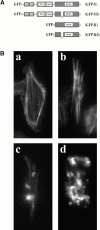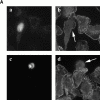Phosphorylation of ADF/cofilin abolishes EGF-induced actin nucleation at the leading edge and subsequent lamellipod extension
- PMID: 11086013
- PMCID: PMC2174362
- DOI: 10.1083/jcb.151.5.1119
Phosphorylation of ADF/cofilin abolishes EGF-induced actin nucleation at the leading edge and subsequent lamellipod extension
Abstract
In metastatic rat mammary adenocarcinoma cells, cell motility can be induced by epidermal growth factor. One of the early events in this process is the massive generation of actin barbed ends, which elongate to form filaments immediately adjacent to the plasma membrane at the tip of the leading edge. As a result, the membrane moves outward and forms a protrusion. To test the involvement of ADF/cofilin in the stimulus-induced barbed end generation at the leading edge, we inhibited ADF/cofilin's activity in vivo by increasing its phosphorylation level using the kinase domain of LIM-kinase 1 (GFP-K). We report here that expression of GFP-K in rat cells results in the near total phosphorylation of ADF/cofilin, without changing either the G/F-actin ratio or signaling from the EGF receptor in vivo. Phosphorylation of ADF/cofilin is sufficient to completely inhibit the appearance of barbed ends and lamellipod protrusion, even in the continued presence of abundant G-actin. Coexpression of GFP-K, together with an active, nonphosphorylatable mutant of cofilin (S3A cofilin), rescues barbed end formation and lamellipod protrusion, indicating that the effects of kinase expression are caused by the phosphorylation of ADF/cofilin. These results indicate a direct role for ADF/cofilin in the generation of the barbed ends that are required for lamellipod extension in response to EGF stimulation.
Figures







Similar articles
-
Synergistic interaction between the Arp2/3 complex and cofilin drives stimulated lamellipod extension.J Cell Sci. 2004 Jul 15;117(Pt 16):3499-510. doi: 10.1242/jcs.01211. J Cell Sci. 2004. PMID: 15252126 Free PMC article.
-
Role of cofilin in epidermal growth factor-stimulated actin polymerization and lamellipod protrusion.J Cell Biol. 2000 Feb 7;148(3):531-42. doi: 10.1083/jcb.148.3.531. J Cell Biol. 2000. PMID: 10662778 Free PMC article.
-
Measurement of barbed ends, actin polymerization, and motility in live carcinoma cells after growth factor stimulation.Cell Motil Cytoskeleton. 2004 Apr;57(4):207-17. doi: 10.1002/cm.10171. Cell Motil Cytoskeleton. 2004. PMID: 14752805
-
Regulating actin dynamics in neuronal growth cones by ADF/cofilin and rho family GTPases.J Neurobiol. 2000 Aug;44(2):126-44. J Neurobiol. 2000. PMID: 10934317 Review.
-
Signal-regulated ADF/cofilin activity and growth cone motility.Mol Neurobiol. 2000 Feb-Apr;21(1-2):97-107. doi: 10.1385/MN:21:1-2:097. Mol Neurobiol. 2000. PMID: 11327152 Review.
Cited by
-
Actin-depolymerizing factor and cofilin-1 play overlapping roles in promoting rapid F-actin depolymerization in mammalian nonmuscle cells.Mol Biol Cell. 2005 Feb;16(2):649-64. doi: 10.1091/mbc.e04-07-0555. Epub 2004 Nov 17. Mol Biol Cell. 2005. PMID: 15548599 Free PMC article.
-
Synergistic interaction between the Arp2/3 complex and cofilin drives stimulated lamellipod extension.J Cell Sci. 2004 Jul 15;117(Pt 16):3499-510. doi: 10.1242/jcs.01211. J Cell Sci. 2004. PMID: 15252126 Free PMC article.
-
BAIAP2L1 enables cancer cell migration and facilitates phospho-Cofilin asymmetry localization in the border cells.Cancer Commun (Lond). 2022 Jan;42(1):75-79. doi: 10.1002/cac2.12239. Epub 2021 Nov 23. Cancer Commun (Lond). 2022. PMID: 34811939 Free PMC article. No abstract available.
-
CofActor: A light- and stress-gated optogenetic clustering tool to study disease-associated cytoskeletal dynamics in living cells.J Biol Chem. 2020 Aug 7;295(32):11231-11245. doi: 10.1074/jbc.RA119.012427. Epub 2020 May 18. J Biol Chem. 2020. PMID: 32424038 Free PMC article.
-
Cofilin-1 and Other ADF/Cofilin Superfamily Members in Human Malignant Cells.Int J Mol Sci. 2016 Dec 22;18(1):10. doi: 10.3390/ijms18010010. Int J Mol Sci. 2016. PMID: 28025492 Free PMC article. Review.
References
-
- Arber S., Brbayannis F.A., Hanser H., Schneider C., Stanyon C.A., Bernard O., Caroni P. Regulation of actin dynamics through phosphorylation of cofilin by LIM-kinase 1. Nature. 1998;393:805–809. - PubMed
-
- Bailly M., Yan L., Whitesides G.M., Condeelis J.S., Segall J.E. Regulation of protrusion shape and adhesion to the substratum during chemotactic responses of mammalian carcinoma cells. Exp. Cell Res. 1998;241:285–299. - PubMed
-
- Bamburg J.R. Proteins of the ADF/Cofilin familyessential regulators of actin Dynamics. Annu. Rev. Cell. Dev. Biol. 1999;15:185–230. - PubMed
Publication types
MeSH terms
Substances
LinkOut - more resources
Full Text Sources
Other Literature Sources
Molecular Biology Databases
Research Materials

